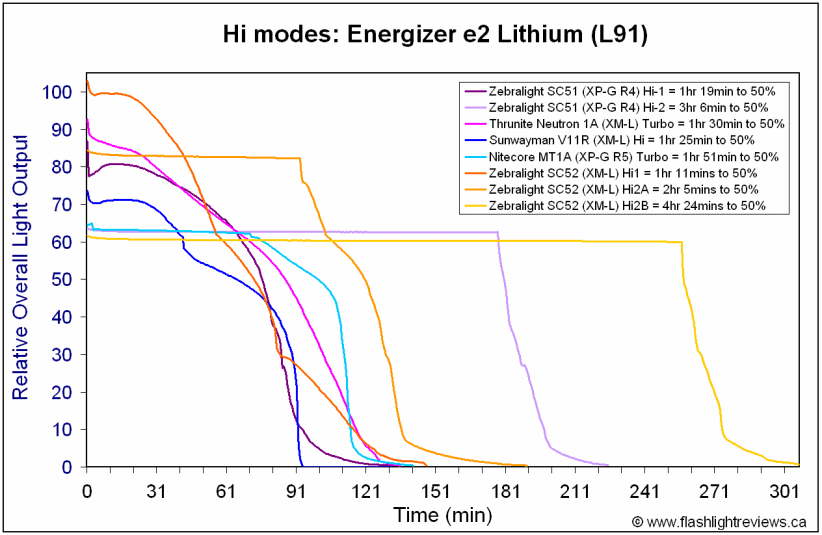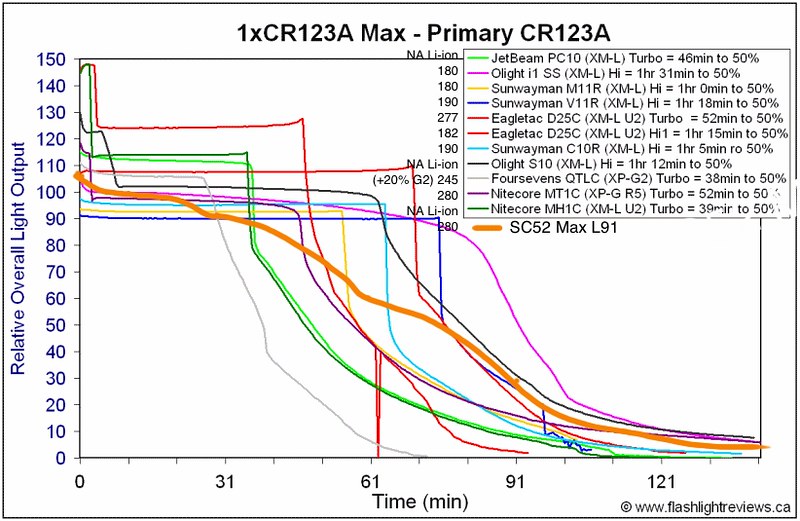This is a long post …. my apologies in advance.
....There's been a lot of people waiting for this review - I am glad the lumen arguments can finally be laid to rest....
....Well, I wouldn't say that exactly. Despite how it may sound above, I'm not trying to shut down any discussion of relative or absolute lumen level estimates. I think it's important to critically evaluate ALL claims of purported "lumen" values, to see if they hold up to scrutiny....
I agree w/ Selfbuilt and I'm quite certain that I am the one that started this whole liberal lumen scale thing with ZL and Selfbuilt. There has been only one other CPF member that has publicly back me, and while I don't always agree with his political correctness in voicing opinions, I sometimes really wonder if it is only the three of us (Selfbuilt included) that truly understand the issues here. Selfbuilt is absolutely a stand-up guy, and sounds to be completely open to this discussion, and without taking any personal offense, for which I truly appreciate. I think we both understand each other. I am sorry that so many others do not get the point…. and/or of course, simply do not care.
Reppans,
....it appears like you have identified some lights whose manufacturers may have understated the lumen output.....
.... These types of mistakes are made, both over and under ratings, and the responsibility for these errors rest squarely upon the manufacturer. The onus of correcting their ratings does not fall to Zebra or Selfbuilt.....
......We use ANSI measurements here. There are no Zebra lumens, Fenix Lumens, or collaborations between Selfbuilt and Zebralight. This past month seems to have brought out some unfortunate comments from some decidedly adversarial posters, calling both Selfbuilts and Zebralights integrity into question.....
First off, there are no official "ANSI " lumens here... please read in detail both Selfbuilt's comments here, and his methodology discussion on his website. He is making an estimate based on a sample of manufacturers (best fit line), and if that sample is skewed, so is his scale. I am doing the same and I know my scale is skewed on the conservative side.
I will admit to being the loudest voice on ZLs spec sheet overstatements and I do question the integrity of the company, partially due to the lumen exaggerations, but also for pulling things like tripling the 0.34 moonlight runtimes (vs a QAAX) by actually delivering only 1/3 of the spec'd lumens. Similar with the 2.7 L1 mode which also matches (sorry, "is supposed to match") the QAAX, and I have highlighted this in my earliest reviews of the SC52. These modes happen to be personal favorites of mine, but they are also important indicators of a flashlight's driver efficiency. Is this an honest mistake, grossly poor estimation, or deliberate misrepresentation? Imagine if Ferarri claimed one of its vehicles got 50 MPG.
I don't have any issues with Selfbuilt's integrity and in fact am even more impressed by his willingness to discuss this issue openly.
While I have more than voiced my opinion about Selfbuilt's liberal lumen calibration, I have also repeatedly said that his data is consistent and relative, and I frequently use his numbers as the basis from which to recalibrate the conservative manufacturers "up" for apples-to-apples comparisons in my posts. The big problem I have with liberal interpretations, especially from someone as respected as Selfbuilt, is that people automatically take it as a de facto ANSI certification. I personally believe, in the longer run, it will reward manufacturer bad behavior and eventually lead to less transparency for all us flashaholics. Having said all that, and I've repeatedly said this too, if I were in Selfbuilt's shoes, I would do the same exact thing. Selfbuit has modestly stated here…..
...Thanks. Yes, at the end of the day, I'll I can say is my relative scale is consistent over time. Even if it does seem slightly inflated, not sure there's much point in trying to come up with a new calibration - it would likely just create confusion between the "new" numbers and the "old". The consistency and backward-compatibility is more valuable in my mind than the absolute correlation.
…. that it doesn't make sense to recalibrate for practical reasons. However, I personally feel there is NO WAY HE CAN RECALIBATE, if only for POLITICAL reasons. Imagine if Selfbuilt were to adopt a more conservative lumen scale and then start reporting that ZL, and a few other liberal manufacturers, are not meeting their specifications. I suspect that Selfbuilt's reviews will diminish in quantity as his supply of flashlights dry up. A man in his position, just like the automobile journalists, must walk a politically fine line with the manufacturers. The only resolution to this, in my mind, is to free Selfbuilt up, by turning him into a "Consumer Reports" of sorts, and have CPF members fund his flashlight purchases. If there's any interest in this, I will happily offer to fund 10% of the pot, when it hits USD 2,000. Selfbuilt, I hope you do not take any offense to my suppositions here, once again, if I were you, I wouldn't do a single thing differently.
Now back the original question of whether ZL is overstating, and Selfbuilt's scale is too liberal. I attach a couple of Selfbuilt's recent Output/Runtime graphs for the 3V, 1xCR123 and 2xAA classes. I took the liberty of including manufacture max lumen specs as best as I could determine, and attempted to superimpose the SC52/L91 graph onto CR123 graph… I hope I've been reasonable fair and accurate with the data, please correct me where I am wrong. Here are the saiient points based on Selfbuilt's review population above:
1) 280 lumens appear to be the highest manufacturer specification (using a non Li-ion battery), and most are significantly lower than that, in the 3V class. The SC52 is spec'd right at that high water mark and with a 1.5V.
2) Despite claiming THE highest lumen spec, the SC52 appears to be the bottom dweller on both charts, and probably, the furthest away from it's claimed spec. (assuming the others are remotely correct)
3) Looking at Selfbuilt's CR123 and 2xAA max lumen tables above, it appears that every light, save ZL and Jetbeam, have been "underrated" by their manufacturers.
4) So, perhaps it is not so much that I've found the few manufacturers that understate their lights, rather, it appears that the current bar is set low enough to accommodate the lowest common denominators.
When we are talking about really statistics and the use of "best fit lines" I strongly believe in bell curves, and for every light that has been understated by its manufacturer, there should be an equal number of lights that have been overstated by its manufacturer. So, where are all these overstated lights?
Selfbuilt, apologies for referring to you in the third person, I feel I am still trying to explain my position to others. In the end, I suspect you may be one of the only people that understands, or cares, what I am talking about. Please do not take any of this personally, I hope it is merely construed as constructive criticism..... you're the best.:twothumbs





